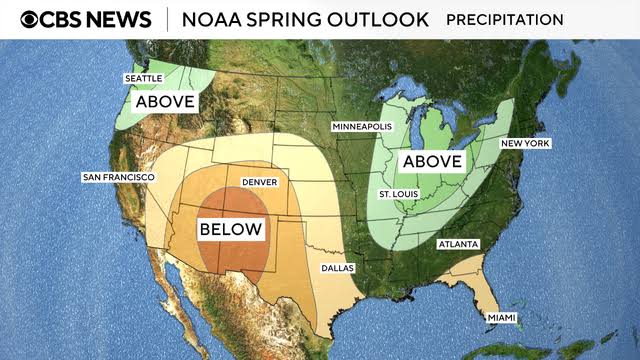Spring is almost here, and if you’ve been dreaming of mild temperatures and gentle showers, you might want to adjust your expectations. The National Oceanic and Atmospheric Administration (NOAA) has just released its official Spring 2025 outlook, and the forecast is shaping up to be anything but ordinary.
From unseasonably warm temperatures to expanding drought conditions, NOAA’s latest predictions show that much of the U.S. is in for a hot, dry, and unpredictable season ahead. Here’s a closer look at what to expect—and how to prepare.
Spring 2025: Warmer-Than-Normal Across Most of the U.S.
One of the biggest takeaways from NOAA’s forecast? It’s going to be warm—very warm.

According to NOAA’s climate models, above-average temperatures are expected across nearly the entire country from March through May. The Southeast, Southwest, and much of the central U.S. are predicted to experience the most intense warming, with some areas potentially breaking records for early-season heat.
Meteorologists say this warming trend is tied to lingering La Niña conditions, which are slowly weakening but still influencing global weather patterns. The result? Less rainfall, more dry air, and hotter days ahead.
Drought Conditions Are Spreading
If you live in California, Texas, or the southern Plains, this next part of NOAA’s outlook might be especially concerning—drought conditions are expected to worsen.
Right now, many parts of the western and central U.S. are already experiencing below-average rainfall, and NOAA predicts things could get even drier this spring. That means:
• Water shortages could become a bigger issue in areas already struggling with drought.
• Farmers and ranchers may face challenges as soil moisture levels drop.
• Wildfire season could start earlier than usual, especially in states like Arizona, New Mexico, and California.
Not Everywhere Will Be Dry – Who Gets the Rain
While the majority of the country will be warmer and drier, some areas could see more storms and rain than usual.
• The Pacific Northwest and the Upper Midwest could experience more frequent storm systems, which might help with drought relief in those areas.
• The Gulf Coast and parts of the Southeast will need to watch for severe thunderstorms, flooding, and possibly even early tornadoes.
• There will probably be a combination of cooler temperatures, sporadic snowfall, and rain across the Northeast and Great Lakes region.
How Will This Affect You?
A warmer, drier spring doesn’t just mean a few extra sunny days—it can impact daily life in several ways:
• Energy bills may rise as people start using air conditioning earlier than usual.
• Water restrictions could be enforced in drought-prone areas, affecting households and farms.
• Increased fire danger could make some regions more vulnerable to wildfires.
• Storm season could be more intense in parts of the South and Midwest.
What You Can Do to Prepare
- Spring is coming fast, and while we can’t control the weather, we can be ready for it.
- Keep yourself cool and hydrated. Check your air conditioner and be ready for an early warm-up if you’re in a hot climate.
- Watch how much water you use. Avoid needless water waste and heed conservation advice if your area is suffering from drought.Anticipate extreme weather conditions.
- Make sure you have an emergency plan in place if you live in a storm-prone area.
- Pay attention to NOAA’s updates. Being knowledgeable is the best way to keep ahead of the curve because weather forecasts can change quickly.
NOAA’s latest outlook makes one thing clear—Spring 2025 is going to be one to watch. Whether your area is dealing with heat, drought, or storms, being prepared will help you navigate the unpredictable season ahead.
For the latest updates and interactive weather maps, visit NOAA’s official website or follow your local meteorologists for real-time forecasts!
